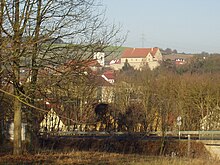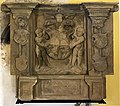Arnstein Castle (Lower Franconia)
| Arnstein Castle | ||
|---|---|---|
|
The current state of the road |
||
| Alternative name (s): | Arnstein Castle | |
| Creation time : | First mentioned in 1225 | |
| Castle type : | Hilltop castle | |
| Conservation status: | Manor house, side house, castle wall, towers | |
| Standing position : | Principality of Würzburg | |
| Construction: | stone | |
| Place: | Arnstein | |
| Geographical location | 49 ° 58 '41.5 " N , 9 ° 58' 13.5" E | |
| Height: | 230 m above sea level NHN | |
|
|
||
Arnstein Castle , also the former Arnstein Official Castle , is a high medieval castle in Arnstein in the Lower Franconian district of Main-Spessart .
Geographical location
Arnstein Castle is located on a sloping mountain spur , at the feet of which the waters of the Wern and the Schwabach unite.
history
founding
The castle complex was first mentioned in 1225. The diocese of Würzburg claimed ownership of the Arnstein castrum in a pamphlet.
The history of its origins is not scientifically proven. It is noteworthy that Arnstein and the surrounding area is an old settlement area, as finds from band ceramics repeatedly prove. The surrounding villages were all named in a document around 800; Arnstein is regularly absent from these records.
One of the most emphatic events of that time were certainly the Hungarian invasions from 907 onwards, also into the Würzburg area. Only the building of the wall could stop the Magyric Horsemen. Possibly the origin of the first fortification of the Arnstein lies here.
Development history
Due to its strategically very favorable location, the castle quickly developed as a bulwark to defend the northern border of the Würzburg diocese. Accordingly, the castle was constantly expanded.
On April 24, 1381, Arnstein Castle and Office was handed over to the von Hutten family as security and pledge. The debts of the diocese under the rule of Bishop Gerhard von Schwarzburg amount to 12056 gold florins.
On November 19, 1440 there was a siege of Arnstein Castle. Bishop Sigismund von Sachsen , Barthelmes von Hutten and Karl von Thüngen defend Arnstein Castle against the Saxon Hessian attackers. All attacks by the besiegers were repulsed, although the city of Arnstein joined the besiegers. The unsuccessful attacks and severe frosts ended the siege.
Bishop Rudolf II von Scherenberg (1466–1495) succeeds in releasing Arnstein Castle by repaying the debts and returning it to the diocese as the official seat . Under his reign, the castle was expanded into a square castle "as an irregular polygon" and thus reached its structural climax and castle character .
When Konrad von Hutten confirmed the repayment on February 22nd, 1489 , Philipp von Weinsberg , the royal councilor from Würzburg, was granted the opportunity to live in Arnstein Castle. He replaced Konrad von Hutten as Arnstein's official.
In 1525 the Peasants' War also reached Arnstein . The castle garrison under bailiff Götz von Thüngen was only "four traveling horses, two traveling servants, a (riding) boy, his servants and his own family" who lived in the castle. On April 23, the castle was taken by the rebels and the bailiff was imprisoned. After the Peasants' War, around 50% of the former castle was destroyed. In the castle walls there were only the old original palace , the mighty keep and the remains of the original "more modern" living quarters of the square castle facing south.
With Bishop Konrad III. The new beginning came from Bibra and the current structure of the castle complex was laid out. Bibra had the keep demolished and integrated the old parts of the building into a new building. The square castle was characterized by a building depth of around 6 m, Konrad von Bibra built a contemporary mansion 16 m wide and 33 m long, which represented a show of power by the diocese. The completion was dated to 1542/1543 with the insignia of the prince-bishop. During the tenure of Bishop Julius Echter von Mespelbrunn , the castle lost its strategic importance due to the emergence of cannons. Julius Echter integrated the previously independent castle complex into the city fortifications . The castle, which was previously closed on the city side, received a gate with a drawbridge , crowned with the coat of arms of Bishop Julius Echter von Mespelbrunn. With Julius Echter, the dark times of the Counter Reformation and the persecution and burning of witches began in Arnstein.
The horrors of the Thirty Years' War did not leave the castle and town without a trace. The castle was often the home of the nobility between or before the campaigns. In 1632 the Swedish King Gustav Adolf stayed at Arnstein Castle.
With the secularization , the diocese lost ownership of the castle, which was now owned by the Bavarian state. In 1803 the Franconian district court was settled in the castle and in 1879 the royal Bavarian district court moved into the castle. These courts met on the first floor in the new courtroom . The presiding judge had his right of residence on the second floor.
During the Second World War , the property was badly hit by tank artillery and the outbuilding was set on fire. The building fabric remained largely intact. The shell impacts can still be seen today on the south side of the outbuilding. In 1973 the castle, which has meanwhile been referred to as the official palace, lost "its jurisdiction" through judicial reform. This ended after around 750 years of jurisdiction over the castle.
Todays use
The castle has been privately owned since 2005. Today it is listed as a landmark building and can be rented for events.
Building description
The castle complex has completely built over the previously visible rock massif. Only the stones in the moat, on which the castle wall is based, still bear witness to the once mighty rock. The medieval town structure on the different levels of the slope with the castle , followed by the town church and town hall , is still preserved in Arnstein. The former, elaborate city fortification into which the castle was integrated (with a total of twelve towers) is only preserved in fragments.
The outbuilding of the former square lock still stands today, which originally had the same height as the main house. Today's main house has included the former building parts of the hall, keep, stables and fountain wing of the square castle. The gatehouses and the buildings that stood against the castle walls were dismantled over the decades. The original castle wall is still standing, just as Prince-Bishop Julius Echter von Mespelbrunn once had it integrated into the city fortifications.
The foundation walls, which are over three meters thick in the foundations and almost two meters thick on the ground floor, are still reminiscent of the castle character of the building. The chimney flues in the outer masonry and the former stairways to the upper floors in the masonry speak for the original building fabric from the time it was built, but which was rebuilt in a modern way from 1542 onwards.
- Interior views
literature
- Ottmar Seuffert: The city of Arnstein and the Werngrund: the development of a Würzburg official city mainly in the 16th century , Würzburg 1990, In: Mainfränkische Studien / Bd. 48 (same as dissertation Würzburg 1987)
Individual evidence
- ↑ Original document from the Würzburg State Archives, Castrum Arnstein, 1225
- ↑ Ottmar Seuffert: The city of Arnstein and the Werngrund , Würzburg 1990, p. 74 ff.
- ↑ Edgar Michael Wenz: A walk through Arnstein and his story , Verlag M. Sturm, Arnstein 1949, p. 14 ff.
- ^ Arnstein Castle: History www.burg-arnstein.de; accessed on October 3, 2018
- ^ Ottmar Seuffert: The city of Arnstein and the Werngrund , Würzburg 1990, p. 381
- ↑ Ottmar Seuffert: The city of Arnstein and the Werngrund , Würzburg 1990, p. 385 ff.
- ↑ Fries chronicle of Prince Bishop Julius Echter UBW, M.ch.f. 760 f. 431 a.
- ^ Ottmar Seuffert: The city of Arnstein and the Werngrund , Würzburg 1990, pp. 387-390
- ↑ Ottmar Seuffert: The City of Arnstein and the Werngrund , Würzburg 1990, p. 400
- ^ Ottmar Seuffert: The town of Arnstein and the Werngrund , Würzburg 1990, pp. 423-425
- ↑ Ottmar Seuffert: The city of Arnstein and the Werngrund , Würzburg 1990, p. 441
- ^ Schütz: Justitia returns , Verlag Fränkischer Tag, Bamberg 1987, p. 31 f.

















